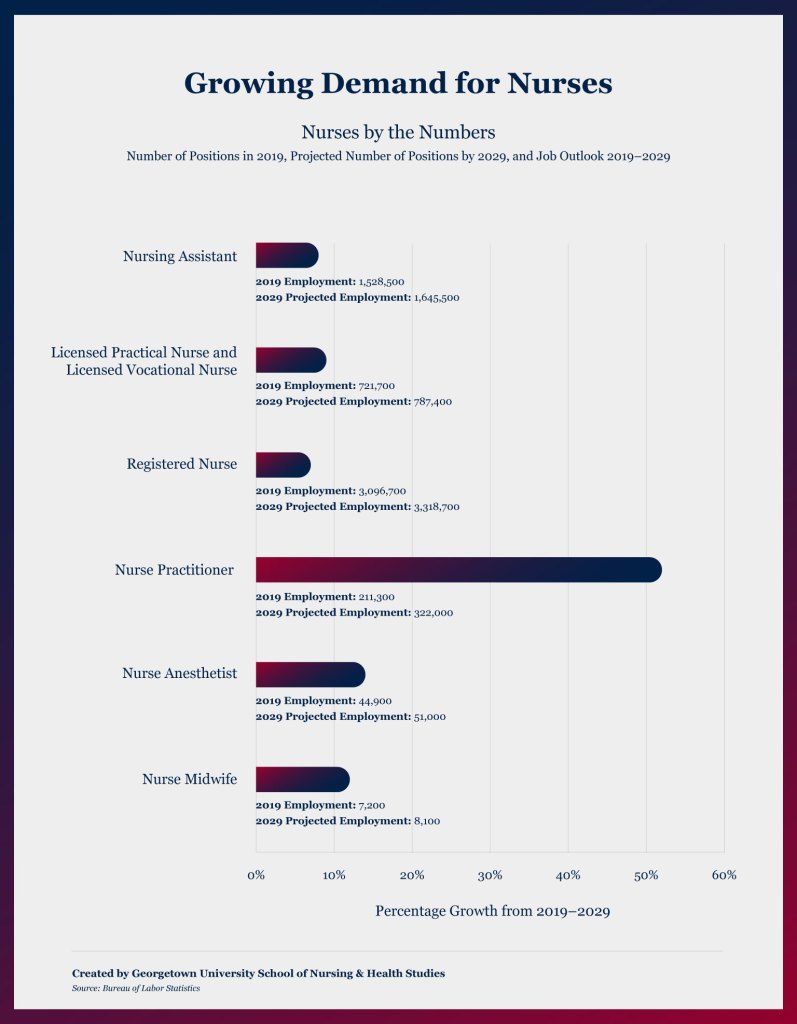How to Become a Nurse

Nursing Degree
Nurses work in a variety of settings, from hospitals and doctors’ clinics to community health centers and nursing homes. As health care professionals, nurses use their clinical skills and expertise to improve patient outcomes.
For those with an interest in the field — or more specifically, a nursing degree — it’s worth noting that there are different pathways to the profession, and pursuing a particular one can prepare aspiring professionals to work with a specific patient population or apply for positions in a sector of their choice.
Here are a some common pathways to a profession in the nursing field:
Non-Degree
People who pursue the non-degree route may become a certified nursing assistant (CNA) (or nursing aide), which requires a course that may take as little as a few weeks to complete and often requires that the candidate pass a competency exam. Performing such duties as bathing patients and recording vitals, these caregivers work under the supervision of registered nurses (RNs) and licensed practical nurses (LPNs). In some states, nursing assistants may receive additional training to dispense medications.
Licensed practical nurses also administer basic patient care under the supervision of a registered nurse. To become an LPN, candidates typically complete a year-long, state-approved educational program and are required to pass the National Council Licensure Exam (NCLEX-PN). This process prepares them to discuss care plans with patients and reinforce the teachings that registered nurses share with patients and their families.
The Bureau of Labor Statistics (BLS) reports that in May 2020, the median annual salary for nursing assistants was $30,850. In that same time period, the median annual wage for LPNs was $48,820. Both occupations are projected to grow much faster than the average for all occupations. Employment of nursing assistants is projected to grow 8% from 2019 to 2029 and employment of LPNs is projected to grow 9%, according to the BLS. While the certified nursing assistant position is generally considered to be entry-level, and LPNs may be limited to doing certain tasks depending on the state where they work, both have opportunities for career advancement with additional education and training.
Associate Degree in Nursing
An associate degree in nursing (ADN) or Associate of Science in Nursing (ASN) degree typically takes at least two years to complete and may lead to careers as an LPN or registered nurse. RNs must obtain a nursing license from the state in which they work. To qualify for a license, graduates of an approved nursing program must pass the National Council Licensure Exam (NCLEX-RN) and may have to meet other individual state requirements for licensure, such as passing a criminal background check.
The BLS reports that in May 2020, the median annual salary for RNs was $75,330, with the highest 10% earning more than $116,230 and the lowest 10% earning less than $53,410. Employment of RNs is projected to grow 7% from 2019 to 2029, faster than the average for all occupations.
Bachelor of Science in Nursing Degree
A Bachelor of Science in Nursing (BSN) typically takes four years to complete and may lead to work as an RN, which is the most prevalent type of nurse than all other nurses combined, according to the BLS. Bachelor nursing degree programs typically add physical and social sciences, communication, leadership, and critical thinking to nursing studies. A bachelor’s degree usually is necessary for administrative positions, research, consulting, and teaching, according to the BLS.
To become an RN, graduates of an approved nursing program must obtain a nursing license from the state in which they work. To do so, they must pass the National Council Licensure Exam (NCLEX-RN) and may have to meet other individual state requirements for licensure, such as passing a criminal background check. RNs may become certified in specific areas such as ambulatory care, gerontology, or pediatrics.
Accelerated Nursing Program
Accelerated nursing degree programs for non-nursing graduates provide an option to professionals seeking to transition to nursing careers.
According to the American Association of Colleges of Nursing (AACN), some accelerated baccalaureate programs may be completed in under 18 months, providing faster routes to licensure as an RN for individuals who have a non-nursing bachelor’s or master’s degree. Accelerated master’s degree programs typically take about three years to complete. Duration to completion depends on the education level of the student enrolling in the program.
RNs who have ADN or ASN degrees may pursue an accelerated RN-to-BSN or even RN-to-MS in Nursing program. The latter allows candidates to obtain both a bachelor’s and master’s degree. These degree options may take up to a few years to complete, depending on previous education and the chosen accelerated path. For RNs, these programs build on what they’ve already learned and provide the education necessary to complete their degree and seek career advancement.
Different types of accelerated programs are available for nurses: LPN, RN, nurse practitioner (NP), and Doctor of Nursing Practice (DNP). The resulting degree depends on the specific program and entry point for the student.
Master of Science in Nursing Degree
Professionals who graduate with a Master of Science in Nursing (MS in Nursing) from accredited programs may pursue careers as nurse anesthetists, nurse midwives, or NPs, also known as advanced practice registered nurses (APRNs), according to the BLS.
MS in nursing degree programs typically include classroom instruction and clinical experience. For those pursuing the NP route, there may be additional specialization courses. NPs typically specialize — they may work in family practice, geriatrics, pediatrics, or psychiatric and mental health. MS in Nursing, RN-to-MS in Nursing, and BSN-to-MS in Nursing programs typically take 18 months to three years to complete, according to AACN.
Requirements vary by state for NPs, and each state’s Board of Nursing will provide that information. NPs typically must have a RN license, complete an accredited graduate program, pass a national certification exam, and have an APRN license. Most states require national certification to become licensed and use the APRN title. Certification typically requires renewals. Among the boards offering certification for NPs, nurse midwives, or nurse anesthetists are:
The median salary for NPs, nurse anesthetists, and nurse midwives was $117,670 in May 2020, according to the BLS, which also states that employment growth for APRNs is projected to be 45% from 2019 to 2029, much faster than average for all occupations.
Join the Next Generation of Nursing Leaders
Earn Your Certificate, Doctorate, or Master’s in Nursing Online from Georgetown University. BSN required.
Request InformationDoctor of Nursing Practice
For those NPs who seek leadership or organizational roles, the Doctor of Nursing Practice is a terminal degree in nursing practice that is an alternative to doctoral programs focused on research, according to AACN, which explains that DNP graduates are equipped to implement the science developed by nurse researchers in PhD and other research-based nursing doctorates.
DNP programs may take anywhere from 18 months to four years or more to complete, depending on the entry level of the student and if the student is doing coursework on a full-time or part-time basis. As NPs, graduates from DNP programs typically specialize in caring for a certain population, and they may work in family practice, geriatrics, pediatrics, women’s health care, or psychiatric and mental health.

Licensure
While there are different pathways to nursing, licensure generally is necessary to practice clinically. To practice as a nursing assistant or nurse, nurses are typically required by states to have licensure or certification in addition to completion of either a state-approved education program or accredited degree program.
Nursing assistants or nursing aides often must pass a state competency exam, which allows them to use state-specific titles, such as certified nursing assistant (CNA). Those who have passed the competency exam are placed on a state registry, which allows them to work in a nursing home, according to the BLS.
The National Council of State Boards of Nursing (NCSBN) is a not-for-profit organization whose members include the nursing regulatory bodies in the United States. NCSBN provides comprehensive information on the licensure exam for LPNs (NCLEX-PN) and RNs (NCLEX-RN).
According to the BLS, nurses must pass the NCLEX-PN to be employed as LPNs, and they must pass the NCLEX-RN to work as RNs.
Specializations
Professionals who complete MS in Nursing or DNP programs and are NPs may provide a full range of primary, acute, and specialty health care services, according to the American Association of Nurse Practitioners. NPs provide care to rural, urban, and suburban populations in a range of settings that include hospitals, clinics, nursing homes, schools, and public health departments.
NPs have areas of specialization, and some of the roles they can fill include the following:
Adult Gerontology Acute Care Nurse Practitioners (AG-ACNPs) care for adult and gerontology patients with complex, acute conditions and may work in intensive care, trauma, or acute care units and focus on complex monitoring and treatment plans.
Adult-Gerontology Primary Care Nurse Practitioners (AGPCNPs) care for young adults to senior patients and assess, diagnose, and plan for their health needs while working in a variety of settings including long-term health care residences, clinics, hospitals, and private practices.
Certified Nurse Midwives (CNMs) deliver babies, manage emergency care during labor, repair lacerations, and may provide surgical assistance to physicians during cesarean births as well as provide wellness care for women, including gynecological exams, family planning assistance, and prenatal care.
Certified Registered Nurse Anesthetists (CRNAs) provide pain management, administer anesthesia, and deliver patient care before, during, and after surgical, therapeutic, diagnostic, and obstetric procedures.
Family Nurse Practitioners (FNPs) are APRNs who care for patients across the lifespan, including infants, adolescents, adults, and seniors, providing a wide range of family-focused health care services in settings ranging from community health centers to health care systems and universities.
Neonatal Nurse Practitioner (NNPs) care for high-risk infants with special needs because of low birth weights, complications of prematurity, heart abnormalities, infections, or other conditions and may be found in emergency rooms, delivery rooms, and neonatal intensive care units.
Women’s Health Nurse Practitioners (WHNPs) assess, diagnose, and treat women’s health care needs throughout their life span, primarily working in private practice settings where they provide a range of women’s wellness services and exams.
Nurses have been caring for patients of all ages and diverse backgrounds for more than a century. A nursing career is worth consideration for those who want to help others. With multiple paths to choose within the profession, graduates with nursing degrees may deliver positive health outcomes to individuals and large populations.


